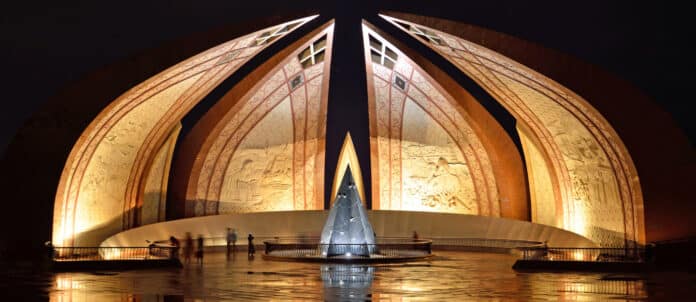The national monument of Pakistan, which consists of a petal-shaped kind of granite structure, is hosted by Shakar Parian hills in Islamabad. The unique and aesthetic monument symbolizes the patriotism and unity of Pakistanis. It is also a tribute to the martyrs of Pakistan. Our history is reflected by looking at its magnificent architecture.
It is one of the most visited places in Pakistan, especially in Islamabad. It is located at such a high place that it is visible from twin cities. Being present at a picturesque location exhibits such a scenic view. One can also reflect on and observe the world’s most beautiful capital.
Following are details mentioned about the national monument.
Conception and History

In 2002, Pervez Musharraf, the former prime minister of Pakistan, proposed creating a national monument in Islamabad. The foundation was laid in 2004, after which the then prime minister asked the Pakistan council of architects and town planners and the ministry of culture to collaborate and create a design for the landmark.
The concept and theme were based on the Pakistani people’s unity, strength, and dedication. After receiving 20 different proposals, three were shortlisted. Mr. Arif Masoud got this opportunity to design this glorious building under engineer Syed Mahmud Khalid’s supervision. The inauguration ceremony was held on 23rd March 2007, and the Pakistan Monument was then open to the public.
Architecture and Design

The monument covers an area of about 2.8 hectares (6.9 acres). Mughal architects inspire the design. The structure is dome-shaped, which was inspired by Mughal muqarnas. It is such a modernized and refined version of Mughal muqarnas.
This design is the representation of solidarity and unity among the Pakistani people. It comprised of 2 main structures- the museum and the monument. Seven petals exhibit the structure of a blooming flower. Four of these petals represent the culture of Pakistan which includes; Sindh, Balochistan, kpk, and Punjab. At the same time, the remaining three small petals represent minorities, including Gilgit Baltistan, Azad Jammu, and Kashmir.
The giant structure is composed of granite bought from brazil and marble bought from Spain. An impressive artwork is crafted on the inner walls of petals. It illustrates several landmarks of Pakistan, including the Khyber Pass, the Badshahi Mosque, Minar-e-Pakistan, and an overview of the story of independence.
Details and Carving

The first petal of the national monument comprised of drawn artwork of Shah Jahan Mosque in Thatta, Makli necropolis, Gawadar port, and Rohtas fort. The second petal illustrated beautiful pictures of our quad Muhammad Ali Jinnah and his sister and mother. Then, it features a picture where a crowd is vowing and cheering at Quaid. The third petal also comprised our national poet, Allama Iqbal, the tomb of shah rukh-e-Alam, Mahabat Khan mosque Indus valley civilization, and the Lahore Fort.
In the end, artwork on the 4th petal reflects the images from uch sharif tomb, sheesh mahal, Islamia College Peshawar, Khyber pass, ziarat residency, and other magnificent places in Pakistan.
If you ponder and view it closely, you will know how these petals exhibit the story of Pakistan’s evolution. A talented team of artists dedicated around 119,000 hours to create this masterpiece. The team worked under the supervision of Zarar Haider Babri and Kausar Jahan.
Unique Features of the Pakistan Monument

A large fountain emerges from the center of the monument, making it a splendid sight for the visitors. Next to it, you can find a wall dedicated to everyone responsible for constructing the monument – it holds the handprints of architects, engineers, designers, and labor involved. The name of the chief architect Arif Masoud is inscribed in stone at the entrance of the main Piazza.
Features like Quaid’s motto, ‘ Unity, Faith, Discipline,’ are displayed therein in Urdu and English. A large fountain is placed in the monument’s center, which makes the sight a splendid one. Also, a wall is dedicated to the creators of this monument.
A beautiful terrace is present adjacent to the monument. Circular entrances are present there that allows a 360-degree view of the whole city. It is an outstanding place to visit and learn.
Pakistan Monument Museum

Islamabad museum, also known as the Pakistan monument museum, is the second part of the grand Pakistan monument. This heritage museum houses several paintings, historical images, and wax statues of historical figures. The chronological representation of history from 7000 BC to 1974 is present there.
A deep understanding of concepts like the advent of Islam, the Mughal era, pre-partition history, the Pakistan movement, and all important events that formed the basis of the partition of the subcontinent comes from visiting the museum. The museum pays tribute to the lives that fought for our separate homeland, Pakistan.
You can visit the library present for historical books, speeches, manuscripts, and old national records, which also has a visual-audio centre. More importantly, a panorama hall and a conference hall are also present, with space for 62 people accommodation.
You can also visit the museum if you visit the grand Pakistan monument.
Pakistan Monument Timings
Timings to visit the Pakistan Monument are from 10 AM to 8 PM, and the weekly holiday is observed on Monday.


